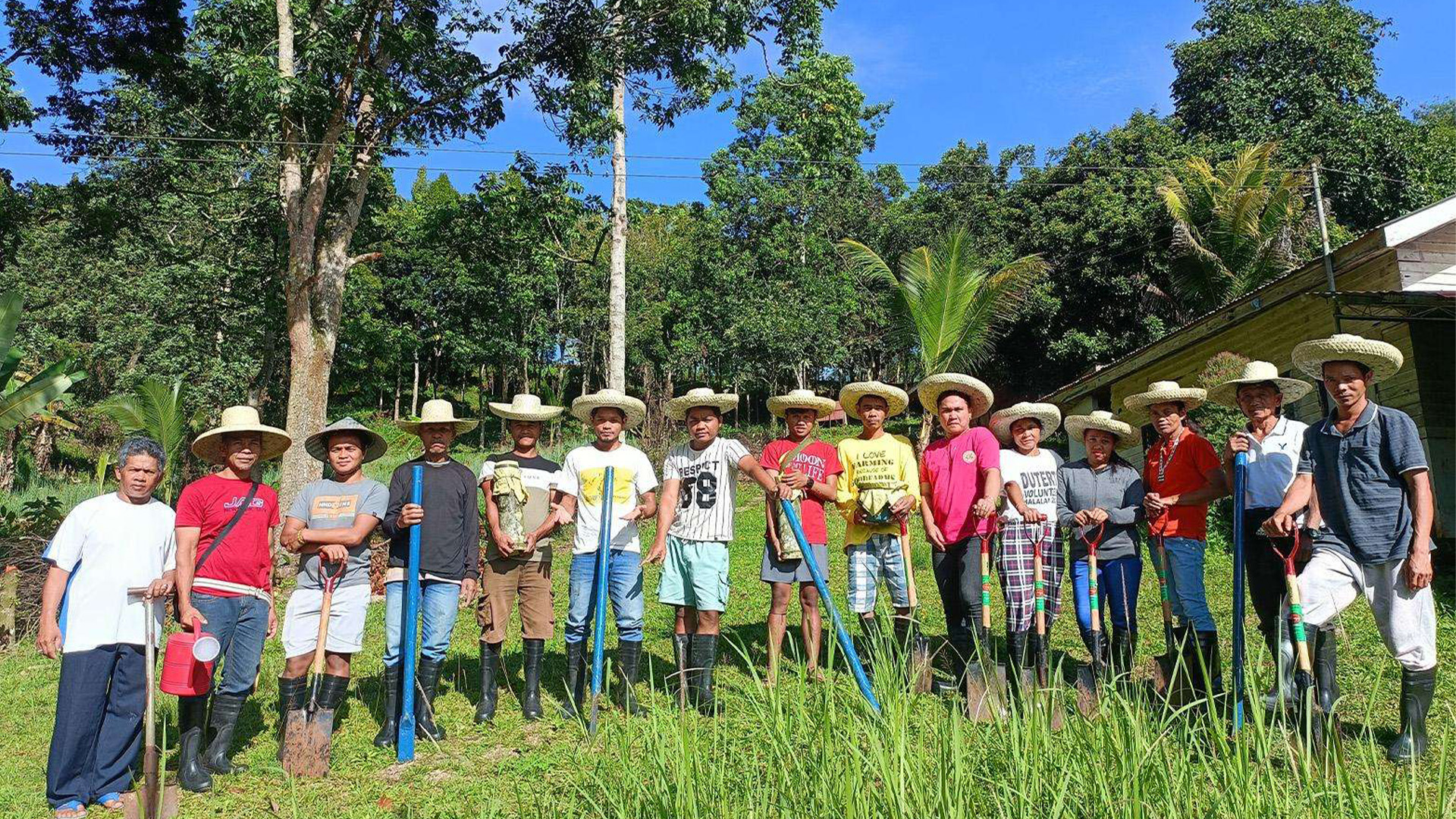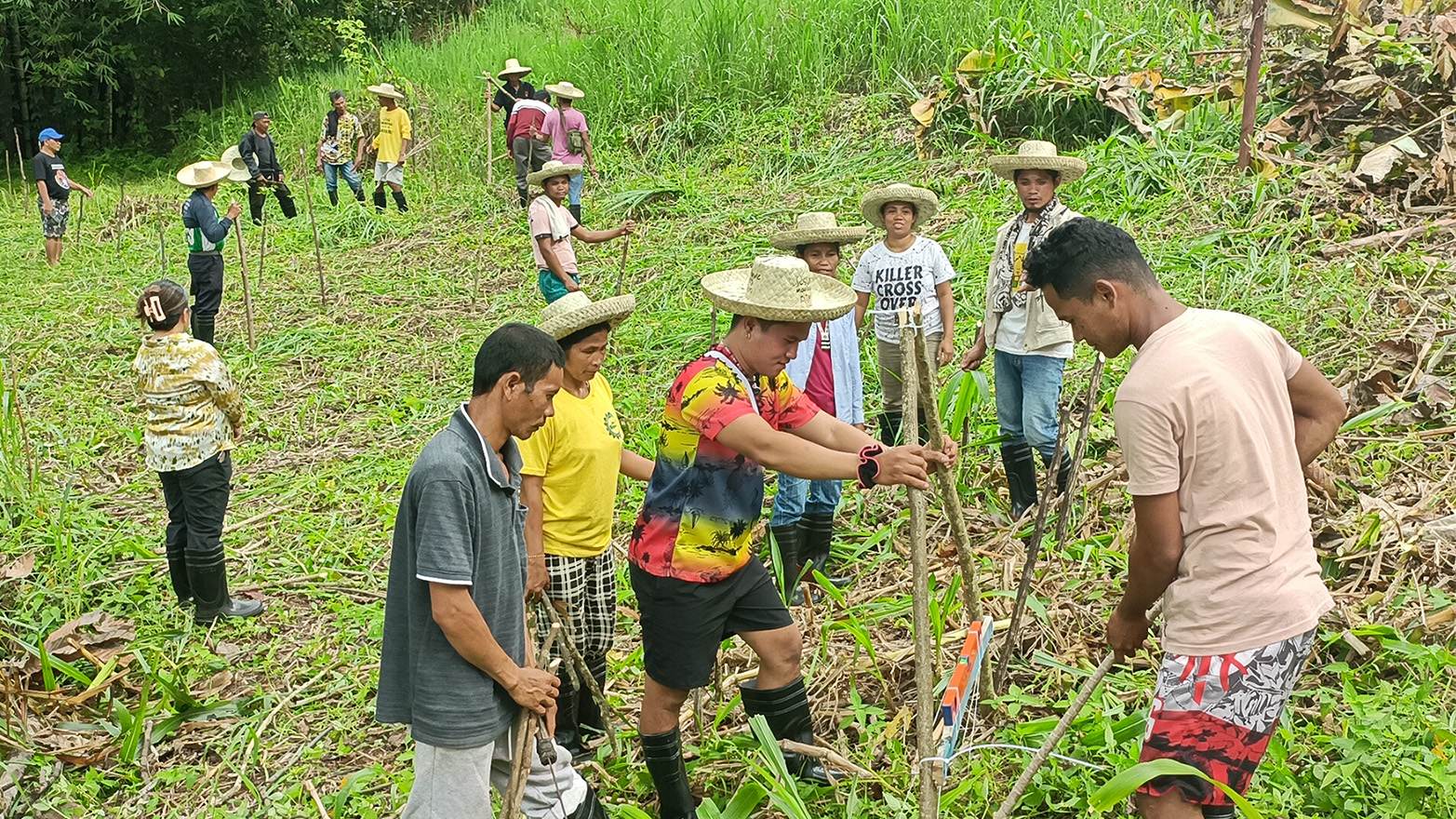
The AGROEKULOHISTA batch 1 of MAG-AGROEKU. Sixteen farmers from partner communities attended the six-day agroecology training held by Samdhana Institute on July 11-16 at the Agroeco Resource Center in Manolo Fortich, Bukidnon. (Photo by Samdhana)
- admin
- 30 September 2023
- Feature
Agroecology Training Held For Partner Communities In Mindanao
Many Lumad or Indigenous communities have adopted the “agribusiness mentality,” that is, producing crops for the market and compromising food security, according to Erwin Rayos of Agroeco Philippines and Samdhana Institute’s technical consultant on agroecology.
In the indigenous communities that Samdhana is partnering with, most of the farmers are mainly producing hybrid corn varieties and cash crops, although there are still root crops and vegetables for domestic consumption.
Alfred Depala, Samdhana’s agroecology officer, added that apart from prioritizing corn and cash crop production, the lack of space has constrained the farmers from planting more vegetables for food. “Some lands were mortgaged,” he explained.
He said Samdhana aims to help indigenous peoples regain food security, through its agroecology program, in particular by holding capability-building activities to develop agroecologists or (farmer teachers), or what the government calls agricultural technicians, in the communities.
The first batch of magsasakang guro had their training on July 11-16 at the Agroeco Resource Center in Barangay Maluko, in Manolo Fortich town in Bukidnon, with 16 participants from eight communities (six in Southern Bukidnon, one in Northern Bukidnon, and one in Cagayan de Oro City).
Alfred said the participants, three of whom are women and three others from the LGBT community, are all practicing farmers and were chosen based on their willingness to learn and their commitment to spread the principles and methods of agroecology to other members of their communities. A training needs analysis was done to enable the participants to see the difference between the training activities conducted by government agencies like the Department of Agriculture and those done by nongovernment organizations.
The participants were also selected by the IP elders, specifically the ibabasok or the indigenous agriculturists. He explained that the elders play an important role since agroecology, as practiced in the country, is based, among others, on indigenous culture, particularly indigenous knowledge systems and the relationships of the natural ecosystem.
He said the agroecology training includes topics on the history of agriculture in the Philippines and agricultural technology, e.g., organic fertilizers, alternative pest management, composting, and organic vegetable production.
He said Samdhana also aims to develop modules that would suit the needs and existing practices of each community. He cited that farming practices may vary from one community to another depending on the local conditions and culture. He added that since agroecology is a generic term each community may have a different name for it, although the underlying concept is similar.
As Samdhana Deputy Executive Director Erwin Quiñones said in his opening message via phone patch during the training, the name doesn’t matter as long it means one and the same thing – agriculture based on the relationship between people and Nature.
Rayos, however, admitted that changing the farmers’ “agribusiness mentality” would take a long time. He noted that only a few Lumad are still practicing agroecological methods, and that it’s not enough to just produce many graduates of agroecology. In their experience, farmers needed constant training, and monitoring is needed encourage them to be consistent with practicing the agroecology principles.
He said that since farmers learn through actual work they have put up “learning farms,” five in Southern Bukidnon, one in Barangay Balintad, Baungon, Bukidnon, and one in Barangay Awang, Opol, Misamis Oriental.
In addition, Rayos said there are also trial farms where they are testing what varieties of rice and vegetables are best suited to a particular area. For example, in Barangay Balintad, they have tested 39 rice varieties that were given by non-Lumad farmers from Agusan del Sur and Quezon, Bukidnon. “Only 17 of the 39 rice varieties grew,” he said.

Roots and principles
The United Nations defines agroecology as a “holistic and integrated approach that simultaneously applies ecological and social concepts and principles to the design and management of sustainable agriculture and food systems.”
Agroecology is being developed, promoted and espoused by other NGOs even from the earlier decades. Over the years, he said, it has been called various nomenclatures – sustainable agriculture, organic agriculture, regenerative agriculture, diversified integrated organic farming system, and conservation agriculture, to mention some. Thus, it can be considered an evolving system.
Samdhana has also developed its framework, anchored on the core areas of its work such as the support for Indigenous Peoples’ rights to tenure, and resilience-building. Samdhana’s agroecology framework seeks to [1] restore and strengthen the relationship of people with Nature; [2] revive and strengthen the spirit of community cooperation; [3] popularize a pro-Nature and culture-based food production system based on IKSP; [4] protection of biodiversity within the ancestral domain; and [5] establish a conservation-based, community resource-based, and community-managed enterprise.
To realize agroecology, Samdhana will encourage its partner communities to establish AgroeCu (Agroecology and Culture) Community Farms. These farms shall undertake production though the diversified integrated organic farming system, processing and food preservation (value-adding), and community-managed social enterprising using the surplus from production.
Apart from these theoretical concepts, the training participants learned through hands-on activities about soil quality management, production and application of organic fertilizer, organic vegetables production, organic cereals production, and alternative pest management.
Alfred said that after the training the participants are expected to establish and develop AgroeCu farms in their communities. He added they are hoping that this would lead to the revival of communal farming. ###
Please download the file below: